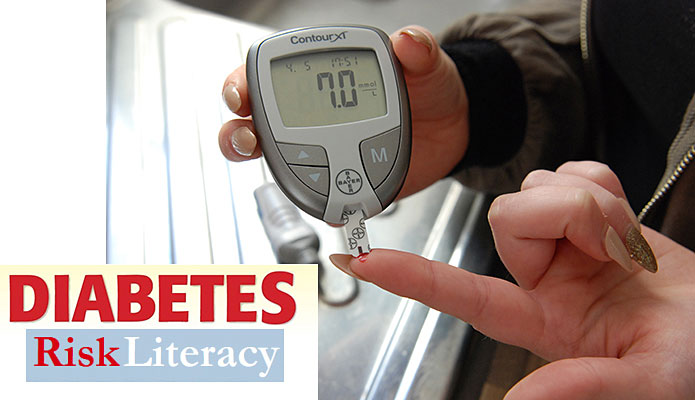Clearer clinical messages will reduce risks for diabetics

Mon, 09 May 2016 10:42:00 BST
“…a medical approach very often may be ineffective unless we improve our communication style and assess patients’ readiness to take information…”
 UNIVERSITY of Huddersfield lecturer Phil Holdich (pictured) is developing more effective ways in which medical practitioners and nurses can help diabetes patients understand risks related to the disease and manage their lifestyles to avoid devastating developments such as blindness, strokes or loss of limbs.
UNIVERSITY of Huddersfield lecturer Phil Holdich (pictured) is developing more effective ways in which medical practitioners and nurses can help diabetes patients understand risks related to the disease and manage their lifestyles to avoid devastating developments such as blindness, strokes or loss of limbs.
Mr Holdich – who has long experience as a specialist diabetes nurse – has completed a doctoral thesis on risk literacy in which he investigates patients and healthcare professionals understanding of risk and the effectiveness of communication of risk between clinicians and people with Type 2 diabetes – much the most common form of the disease. He conducted his research by recording actual consultations, giving him a unique perspective on the issues.
Now, he recommends a review of approaches to diabetes consultations and new forms of pragmatic patient education that acknowledge the importance of how patients understand and interpret risk, known as risk literacy, could include greater use of visual metaphors and narratives from real-life case studies.
In addition to his thesis, Mr Holdich is disseminating his research at international conferences and his ideas also contribute to teaching at the University of Huddersfield’s School of Human and Health Sciences, where he leads diabetes courses and teaches on modules that involve a wide range of healthcare disciplines, from nursing to pharmacy.
 “I have been working in diabetes care for over 20 years and the problem we have always had is that we know the evidence from the different medical trials and interventions that help us support people in managing diabetes, but we’re not always terribly good at communicating it,” said Mr Holdich.
“I have been working in diabetes care for over 20 years and the problem we have always had is that we know the evidence from the different medical trials and interventions that help us support people in managing diabetes, but we’re not always terribly good at communicating it,” said Mr Holdich.
“With a condition like Type 2 diabetes – which is what 90 per cent of adults with diabetes have – the potential risks include losing your sight, damage to the kidneys, heart disease, strokes and lower limb amputation,” he added.
Daily battle between the physical risks
Although outcomes are predicted on factors such as control of blood glucose levels or blood pressure, risk may be difficult to interpret for clinicians and people with diabetes. This may create uncertainty about the future onset of complications, or assumptions are made about what is important to people with diabetes which may not concur with the healthcare professional view.
Mr Holdich argues that although there are underlying genetic issues and factors such as body weight that can lead to diabetes, it is predominantly a lifestyle condition. Therefore, the management of lifestyle is vital in treatment.
“What we have often failed to appreciate is the social impact of diabetes. There are competing priorities for patients because there is daily a balance between the physical risks related to the diabetes alongside managing it as a social condition,” he said.
Patients must fit requirements for diet and exercise into their everyday life, whether it is at work or with their family, added Mr Holdich. At various stages in a patient’s life with diabetes, they may be more engaged and at other times, there may be competing priorities that mean patients are less attentive. Therefore, maybe more patient-centred measures, such as if patients feel better about their diabetes and are able to manage diabetes risks in their social lives, should receive the same attention as biomedical outcomes.
 He advocates techniques that are meaningful and empower people with diabetes to be in charge of their diabetes. Whilst targets are important, at times it feels like we are hostage to metabolic measures. Patient decision-making aids, which use numbers, may be less powerful than the use of visual metaphors – comparing the kidneys to a sieve, for example.
He advocates techniques that are meaningful and empower people with diabetes to be in charge of their diabetes. Whilst targets are important, at times it feels like we are hostage to metabolic measures. Patient decision-making aids, which use numbers, may be less powerful than the use of visual metaphors – comparing the kidneys to a sieve, for example.
Also, clinicians could use examples of how others manage their diabetes based on personal experience of previous patients. These approaches are often seen as informal, or anecdotal, yet could help to create greater “risk literacy”, said Mr Holdich, who added that the innovative nature of his research is that it brings together different strategies.
“It acknowledges amongst other things that a medical approach very often may be ineffective unless we improve our communication style and assess patients’ readiness to take information.”
- Mr Holdich has presented his research at the recent Diabetes UK Professional Conference in Glasgow. He will also attend the annual spring conference of the Universities Safety and Health Association in Belfast and the 16th International Conference on Integrated Care taking place in Barcelona (23-25 May).







